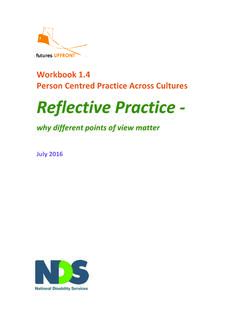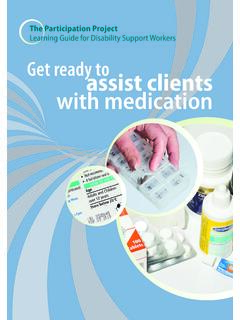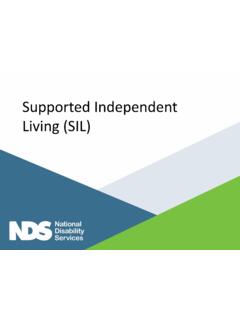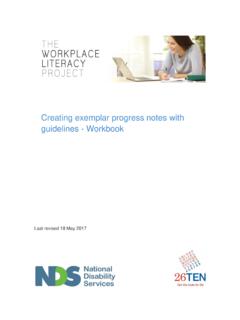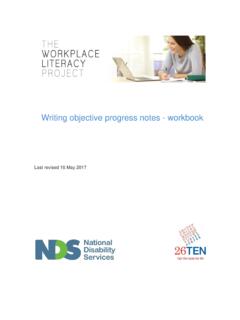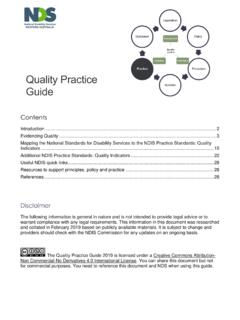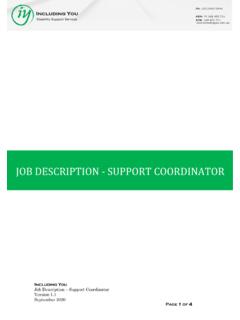Transcription of NDIS Practice Standards Interpretive Guide
1 NDIS Practice Standards Interpretive GuideAcknowledgement This resource was created by National Disability Services Inc (NDS). Development of this Guide has been supported through grant funding from the Australian Government via the NDIS Commission s Support for Providers Program . Information included in this resource has been built with publically available information from the NDIS Quality and Safeguards Commission as well as knowledge gained through NDS sector engagement National Disability Services Limited (NDS) believes that the information contained in this publication is correct at the time of publishing.
2 However, NDS reserves the right to vary any of this publication without further notice. The information provided in this publication should not be relied up on instead of other legal, medical, financial or professional to the NDIS Practice Standards Interpretive Guide ..4 Division 1 Rights and Responsibilities ..6 Outcome Person-centred supports ..6 Outcome Individual values and beliefs ..9 Outcome Privacy and Dignity ..11 Outcome Independence and Informed Choice ..14 Outcome Violence, Abuse, Neglect, Exploitation and Discrimination ..19 Division 2 Provider Governance and Operational Management.
3 22 Outcome Governance and Operational Management ..22 Outcome Risk Management ..28 Outcome Quality Management ..32 Outcome Information Management ..35 Outcome Feedback and Complaints Management ..39 Outcome Incident Management ..43 Outcome Human Resource Management ..47 Outcome Continuity of Supports ..53 Division 3 Provision of Supports ..59 Outcome Access to Supports ..59 Outcome Support Planning ..62 Outcome Service Agreements with Participants ..68 Outcome Responsive Support Provision ..72 Outcome Transitions to or from the provider ..76 Division 4 Support Provision Environment.
4 79 Outcome Safe Environment ..79 Outcome Participant Money and Property ..82 Outcome Management of Medication ..85 Outcome Management of Waste ..884 Introduction to the NDIS Practice Standards Interpretive GuideThis Interpretive Guide is for organisations preparing to re-register as an NDIS provider. The aim is to help providers that are required to meet Certification requirements with the NDIS Commission, to interpret and better understand the requirements of the NDIS Practice Standards Core Module and associated quality indicators. The Guide provides both an explanation of what each indicator means and provides some examples of documentary evidence that may meet the requirement of the quality to use the GuideThis Guide can be used as a working document to prepare for your self-assessment against the relevant NDIS Practice Standards .
5 It lists each outcome and quality indicator. Against each quality indicator, it provides the following information and tools; an interpretation of each quality indicator for the CORE Module of the NDIS Practice Standards and some useful links examples of documentary evidence that could demonstrate your organisation actively meet the requirements opportunity for providers to list/identify gaps opportunity to allocate responsibility for, and determine how you might meet the identified gaps that could form an action evidenceRegistered providers are audited against the Standards and need to provide evidence on how the Standards are implemented.
6 Evidence needs to be proportionate to the size and scale of the provider National Disability Scheme Insurance (Provider Registration and Practice Standards ) Rules 2018 specify the types of evidence that auditors are required to collect including:(a) information directly from participants (b) information from family/friends/carer/nominees and/or independent advocates (with participant consent)(c) the documented support plan and evidence of the delivery of supports to execute the plan (d) all the supports delivered by the NDIS provider to the are expected to demonstrate best Practice through innovative, responsive service delivery, underpinned by the principles of continuous improvement of the systems, processes and associated with the outcomes.
7 Auditors will check a variety of reliable sources to corroborate and confirm your claims. They will check whether the provider is meeting the expectations of participants and where appropriate, assisting them to attain their goals. Information for participants, family and careers needs to be accessible and easy to understand. Communication with participants should be in the preferred style. NoteThis Guide does not cover all processes or practices relevant to all providers. It is important to interpret the information provided with respect to your own circumstances. The Practice Standards state that the processes you use to meet the indicators will be proportional to the size and scope of supports you deliver.
8 It is important to use the information provided as a Guide to help you think about what your own organisation may have or do that fits with the intention of the indicator. This is important for small organisations that will need less complex systems and processes than larger organisations due to the size of the staff population, number of outlets, range and complexity of supports provided etc. The NDIS Commission acknowledges the complexity of your quality systems should not be outweighed by the important NDIS resourcesThis resource is not designed to replace NDIS Commission rules or guidance, and should be considered in conjunction with other important resources including:NDIS Commision website Practice Standards -NDIS Practice Standards and Quality Indicators Renewal Process Guide -Information for registered NDIS providers seeking to renew their registration 1 Rights and Responsibilities Outcome supports Participant outcome.
9 Each participant accesses supports that promote, uphold and respect their legal and human rights and is enabled to exercise informed choice and control. The provision of supports promotes, upholds and respects individual rights to freedom of expression, self-determination and Indicators Each participant s legal and human rights are understood and incorporated into everyday this meansHow the provider makes sure participants rights are understood by staff and participants, and the extent to which delivery of supports is planned and conducted in ways that promote, respect and protect participants examples of evidence to support meeting this indicatorStatement of participant rights that outlines how participants can expect to be treated.
10 Participant rights information provided in brochures, service agreement, participant information pack. Staff position descriptions and training records. Code of Conduct signed by staff. Examples of policies and procedures that implement rights promotion and protection. Human Rights/Customer gaps/opportunities for your own improvement Your work plan!Who or how will you address the identified gap7 Outcome Rights and Responsibilities Division 1 Quality Indicators Communication with each participant about the provision of supports is responsive to their needs and is provided in the language, mode of communication and terms that the participant is most likely to this meansInformation and other forms of communication with participants about the supports you provide, is mindful and takes into account their individual communication needs to maximise comprehension of your messages.




